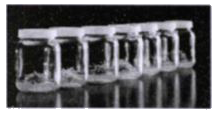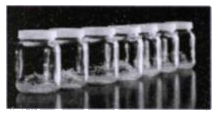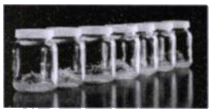In a culture, the bacteria count is 1,00,000. The number is increased by 10% in 2 hours. In how many hours will the count reach 2,00,000, if the rate of growth of bacteria is proportional to the number present?
To solve the problem, we will follow these steps:
Step 1: Set up the differential equation
Given that the rate of growth of bacteria is proportional to the number present, we can express this mathematically as:
dbdt=k⋅b
where b is the number of bacteria and k is the proportionality constant.
Step 2: Separate the variables
We can separate the variables to integrate:
dbb=kdt
Step 3: Integrate both sides
Integrating both sides gives:
∫dbb=∫kdt
This results in:
ln|b|=kt+C
where C is the constant of integration.
Step 4: Solve for b
Exponentiating both sides, we have:
b=ekt+C=eC⋅ekt
Let A=eC, then:
b=Aekt
Step 5: Use initial conditions to find A
We know that initially (at t=0), the bacteria count is 100,000:
b(0)=100,000⟹A=100,000
Thus, the equation becomes:
b=100,000ekt
Step 6: Use the second condition to find k
After 2 hours, the bacteria count increases by 10%, so:
b(2)=100,000+10%⋅100,000=110,000
Substituting into the equation:
110,000=100,000e2k
Dividing both sides by 100,000:
1.1=e2k
Taking the natural logarithm:
ln(1.1)=2k⟹k=ln(1.1)2
Step 7: Find the time when b=200,000
Now we want to find the time t when b=200,000:
200,000=100,000ekt
Dividing both sides by 100,000:
2=ekt
Taking the natural logarithm:
ln(2)=kt
Substituting k:
ln(2)=ln(1.1)2t
Solving for t:
t=2ln(2)ln(1.1)
Step 8: Calculate the value of t
Using approximate values for the logarithms:
- ln(2)≈0.693
- ln(1.1)≈0.0953
Thus:
t≈2×0.6930.0953≈1.3860.0953≈14.56 hours
Final Answer
The bacteria count will reach 200,000 in approximately 14.56 hours.
---
Given that the rate of growth of bacteria is proportional to the number present, we can express this mathematically as:
dbdt=k⋅b
where b is the number of bacteria and k is the proportionality constant.
We can separate the variables to integrate:
dbb=kdt
Integrating both sides gives:
∫dbb=∫kdt
This results in:
ln|b|=kt+C
where C is the constant of integration.
Exponentiating both sides, we have:
b=ekt+C=eC⋅ekt
Let A=eC, then:
b=Aekt
We know that initially (at t=0), the bacteria count is 100,000:
b(0)=100,000⟹A=100,000
Thus, the equation becomes:
b=100,000ekt
After 2 hours, the bacteria count increases by 10%, so:
b(2)=100,000+10%⋅100,000=110,000
Substituting into the equation:
110,000=100,000e2k
Dividing both sides by 100,000:
1.1=e2k
Taking the natural logarithm:
ln(1.1)=2k⟹k=ln(1.1)2
Now we want to find the time t when b=200,000:
200,000=100,000ekt
Dividing both sides by 100,000:
2=ekt
Taking the natural logarithm:
ln(2)=kt
Substituting k:
ln(2)=ln(1.1)2t
Solving for t:
t=2ln(2)ln(1.1)
Using approximate values for the logarithms:
- ln(2)≈0.693
- ln(1.1)≈0.0953
t≈2×0.6930.0953≈1.3860.0953≈14.56 hours
The bacteria count will reach 200,000 in approximately 14.56 hours.
Topper's Solved these Questions
- DIFFERENTIAL EQUATIONSBOOK - NCERTCHAPTER - DIFFERENTIAL EQUATIONSEXERCISE - SOLVED EXAMPLES
28 Videos
- DIFFERENTIAL EQUATIONSBOOK - NCERTCHAPTER - DIFFERENTIAL EQUATIONSEXERCISE - EXERCISE 9.3
12 Videos
- DIFFERENTIAL EQUATIONSBOOK - NCERTCHAPTER - DIFFERENTIAL EQUATIONSEXERCISE - EXERCISE 9.6
19 Videos
- DETERMINANTSBOOK - NCERTCHAPTER - DETERMINANTSEXERCISE - EXERCISE 4.4
5 Videos
- INTEGRALSBOOK - NCERTCHAPTER - INTEGRALSEXERCISE - EXERCISE 7.4
25 Videos
Similar Questions
In a culture the bacteria count is 100000. The number is increased by 10% in 2 hours. In how many hours will the count reach 200000, if the rate of growth of bacteria is proportional to the number present.
View SolutionThe rate of increase in the number of bacteria in a certain bacteria culture is proportional to the number present. Given the number triples in 5 hrs., find how many bacteria will be present after 10 hours. Also find the time necessary for the number of bacteria to be 10 times the number of initial present. [Given loge3=1.0986, e2.1972=9 ]
View Solution
Knowledge Check
The bacteria in a culture grows by 10% in the first hour, decreases by 10% in the second hour and again increases by 10% in the third hour. If the original count of the bacteria in a sample is 10000, find the bacteria count at the end of 3 hours.
A13310B10890C10990D11000Read the following text and answer the following questions on the basis of the same: The rate of increase in the number of bacteria in a certain bacteria culture is proportional to the number present. Given that the number triples in 5 hours.

If N0 is the initial count of bacteria, after 10 hours the count is __________ .A15log3B3logN0C9N0D2N0Read the following text and answer the following questions on the basis of the same: The rate of increase in the number of bacteria in a certain bacteria culture is proportional to the number present. Given that the number triples in 5 hours.

The bacteria becomes 10 times in ___________ hours.A5log7B5log10log3C5log3Dlog(1053)
In a certain experiment the count of bacteria was increasing at the rate of 2.5% per hour. Initially, the count was 5,12,000. Find the bacteria at the end of 2 hours.
View SolutionAn initial number of bacteria presented in a culture is 10000. This number doubles every 30 minutes. How long will it take to bacteria to reach the number 100000 ?
View SolutionThe bacteria in a culture grows by 10% in the first hour, decreases by 10% in the second hour and again increases by 10% in the third hour. If the original count of the bacteria in a sample is 10000, find the bacteria count at the end of 3 hours.
View Solution∫1Kxdx=_________ .
View SolutionRead the following text and answer the following questions on the basis of the same: The rate of increase in the number of bacteria in a certain bacteria culture is proportional to the number present. Given that the number triples in 5 hours.

The general solution is _________ .
View Solution
